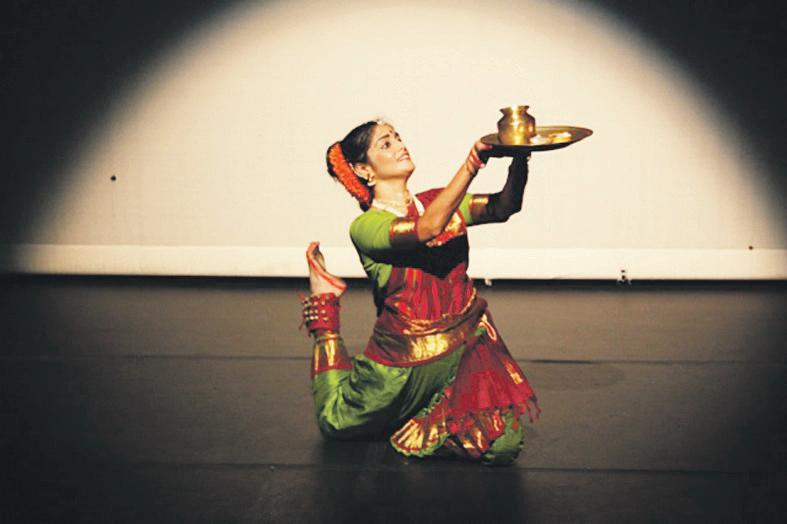
4 minute read
Indian dance doco
from 2013-05 Sydney (2)
by Indian Link
The contrasting traditions of Bharatanatyam and Kuchipudi are explored in Sutra – Secrets of Classical Indian Dance
BY USHA RAMANUJAM ARVIND

Originating in the temples of Tamil Nadu several thousand years ago, the story of classical Indian dance is a complex one. Quite like the turbulent history of its motherland, this ancient art form underwent periods of growth and decline, before its renaissance in the twentieth century.
Using the parallel, but often contrasting traditions of Bharatanatyam and Kuchipudi, it is this complex tale that talented siblings Sandhya and Govind Pillai chronicled through their dance documentary Sutra – Secrets of Classical Indian Dance
The three hour long production, which included footage from archives (painstakingly collated by Govind Pillai and Adrian Van Ray), in-depth interviews with experts, as well as live dance recitals, was recently staged at Riverside Theatre Parramatta.
A philanthropic venture of Karma Dance Company (in aid of domestic violence victims), Sutra first débuted in New Zealand. Since then it has had encore performances at prestigious venues across Victoria and Tasmania.
What makes the production particularly remarkable is the fact that the artistes involved in the performance were scattered across many cities in Australia and New Zealand, juggling hectic professional schedules in the process.
This time round, Sutra raised valuable funds for fledgling NSW refugee women’s support group, Shakti.
Govind Pillai has enjoyed a long and productive relationship with Sydney audiences. A senior student of Hamsa Venkat, he has often been the centerpiece of her Bharatanatyam productions. With every performance, Govind reaffirms his deep-rooted passion and commitment to this genre.
What sets him apart is his ability to experiment and innovate without sacrificing age-old traditions as laid down in Naatya Shastraa
Interestingly, it was his sister Sandhya, who first inspired Govind to give this “gynocentric” art form a go. While Govind focused on his core skills in
Bharatanatyam, Sandhya chose to additionally explore Kuchipudi and Mohini Aattam Sutra offers the Pillai duo a unique opportunity to compare and contrast the subtle nuances of these traditional genres, while also recounting a broader saga.
Adeptly combining diverse elements, the brother-sister duo explored the entire body of Natya Shastra, appealing to audiences, young and old, amateur and seasoned.
The opening Kauthuvam, a traditional temple dance dating back to 17th century, explored the nuances of Bharatanatyam and Kuchipudi, while highlighting the contrasts.
While Bharatanatyam is a subjective art form, it is equally analytical and firmly grounded on pure mathematical principles. What followed in the Jathiswaram (which is essentially devoid of meaning) was a tribute to the rhythmic patterns, intricate footwork and geometric postures. Govind chose to pay obeisance to a rare composition, the Mysore Jathi to demonstrate the importance of these underlying principles.
Hand gesture, or mudra, is another core element of dance repertoire. Likewise, ranging from compassionate to fiercely protective, female energy is an endearing aspect of Hindu ethos. Exploring complex symbolism of Akhilandeshwari, Sandhya elaborated on the rich body of mudras through Shakthi, the mother goddess’ eight forms.
Testing not just the knowledge, but stamina of the artist, Varnam is the highpoint of any recital. As Govind beautifully summed it up, the Varnam offers a “Substantial body of ideas for the audience to ruminate on”. Govind chose to idolise the much loved but reluctant hero of Indian classics, Hanuman. The staple of every child’s imagination, the story of Hanuman’s quest for the celestial mango was portrayed brilliantly in the Varnam, as was Hanuman’s antics in the palace of the mighty king Ravana. The musical score was a perfect accompaniment to the piece, which reached a crescendo with this varnam. It transcended all linguistic barriers to drown the audience in sheer joy.
The lead vocalists Krishna Ramarathinam, Sangeetha Ayyar and Hamsa Venkat (nattuvangam) were complemented perfectly on the instruments by Anita Das (violin) and Venkat Ramakrishnan (mrudangam).
The magical notes of mrudangam and violin effortlessly recreated the sounds needed as Hanuman playfully knocked on the pillars of Lanka to create truly enchanting music.
If varnam tests the stamina, tharangam, which is the centerpiece of a Kuchipudi recital, challenges the dexterity and composure of performer. As Sandhya’s feet were delicately poised on the rims of a brass plate, the use of props like burning lamps and a water filled brass pot, placed additional demands on her balance and composure. Sandhya effortlessly proved her mastery over the rhythmic complexities through this demanding item.

Having demonstrated their individual prowess, the duo came together for a memorable piece that celebrated the unique brother-sister relationship. And what better story to tell than that of Draupadi and Krishna, whose undying affection is celebrated to this day through the sacred Raksha Bandhan festival.
Having delineated the traditional aspects of dance, Govind next chose to integrate broader western concepts in a unique fusion piece. Incorporating elements from Native American to jazz and techno music, he demonstrated the adaptability and resilience of this genre to novel techniques.
The Thillana, another key element of a traditional recital incorporated an element of surprise by introducing Mohini Aattam, or the seductive body movements and facial gestures.
Set in Raagam Dhanyashree to Aadi Taalam, Sandhya focused on elaborate eye movements and graceful gestures. No recital is complete without a chapter on Krishna.
The artistes involved in the performance were scattered across many cities in Australia and New Zealand
Little Sreenidhi Nair, no doubt inheriting her mother’s passion for dance, more than proved her mettle with an elegant performance.
The evening concluded with the customary Mangalam as the artistes expressed their gratitude not just to the divine forces and gurus but the accompanying artistes and audience as well.
Such skilled recitals no doubt speak volumes of the artistes’ commitment to keeping an ancient tradition alive. The flawless dance documentary is clearly the product of hours dedicated to coordinating, choreographing and rehearsing the performance. Kudos to the entire unit, both on and off stage.










